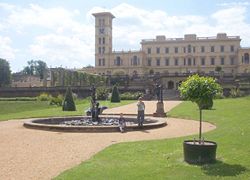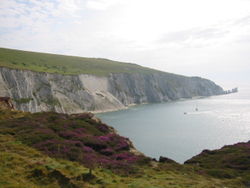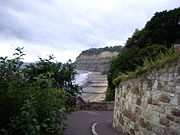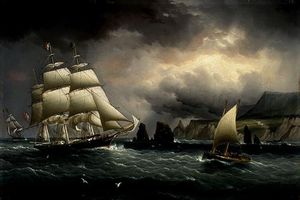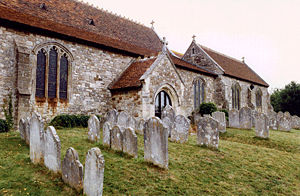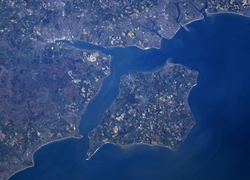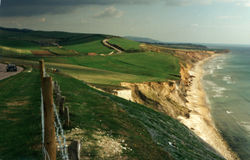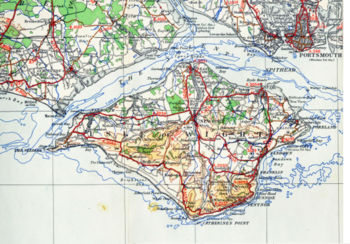Isle of Wight
2008/9 Schools Wikipedia Selection. Related subjects: Geography of Great Britain
| Isle of Wight | |
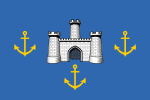 |
|
| Motto of County Council: All this beauty is of God | |
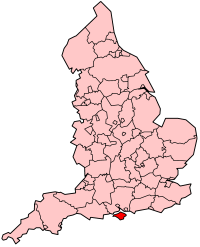 |
|
| Geography | |
| Status | Ceremonial & Non-metropolitan/ Unitary county |
|---|---|
| Region | South East England |
| Area - Total |
Ranked 46th 380 km² (147 sq mi) |
| Admin HQ | Newport |
| ISO 3166-2 | GB-IOW |
| ONS code | 00MW |
| NUTS 3 | UKG11 |
| Demography | |
| Population - Total (2006 est.) - Density - Admin. council |
Ranked 140,000 368/km² (953/sq mi) Ranked |
| Ethnicity | |
| Politics | |
| Conservative | |
| Executive | |
| Members of Parliament |
|
| Districts | |
The Isle of Wight is a British island and county in the English Channel between three and five miles from the south coast of Great Britain. It is situated south of the county of Hampshire and is separated from mainland England by the Solent. Popular since Victorian times as a holiday resort, the Isle of Wight is known for its outstanding natural beauty and for its world-famous sailing based in Cowes.
The Island has a rich history including its own brief status as a nominally independent kingdom in the fifteenth century. It was home to the poet Alfred Lord Tennyson, and Queen Victoria built her much loved summer residence and final home Osborne House at East Cowes. The Island's maritime and industrial history encompasses boat building, sail making, the manufacture of flying boats, the world's first hovercraft and the testing and development of British space rockets. It is home to the Isle of Wight International Jazz Festival, Bestival and the recently revived Isle of Wight Festival, which, in 1970, was one of the largest rock music events ever held. The island has some exceptional wildlife and is also one of the richest fossil locations for dinosaurs in Europe.
The island has in the past been part of Hampshire, however it became an independent administrative county (although still sharing the Lord Lieutenant of Hampshire) in 1890. In 1974 it was reconstituted as a non-metropolitan and ceremonial county with its own Lord Lieutenant and the name was adopted as a postal county. The island is the smallest ceremonial county in England at high tide, but its land area at low tide is larger than Rutland's. With a single Member of Parliament and 132,731 permanent residents according to the 2001 census, it is also the most populated Parliamentary constituency in the United Kingdom.
History
Early history
The Isle of Wight is first mentioned in writing in Geography by Claudius Ptolemaeus.
At the end of the Roman Empire the island of Vectis became a Jutish kingdom ruled by King Stuf and his successors until AD 661 when it was invaded by Wulfhere of Mercia and forcibly converted to Christianity at sword point. When he left for Mercia the Islanders reverted to paganism.
In AD 685 it was invaded by Caedwalla of Wessex and can be considered to have become part of Wessex. Following the accession of West Saxon kings as kings of all England, it then became part of England. The island became part of the shire of Hampshire and was divided into hundreds as was the norm.
In 686, it became the last part of England to convert to Christianity.
The Island suffered especially from the Vikings. Alfred the Great's navy defeated the Danes in 871 after they had "ravaged Devon and the Isle of Wight".
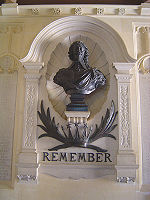
Middle ages
The Norman Conquest created the position of Lord of the Isle of Wight. Carisbrooke Priory and the fort of Carisbrooke Castle were founded. The Island did not come under full control of the Crown until it was sold by the dying last Norman Lord, Lady Isabella de Fortibus, to Edward I in 1293.
The Lordship thereafter became a Royal appointment, with a brief interruption when Henry de Beauchamp, 1st Duke of Warwick was in 1444 crowned King of the Isle of Wight, with King Henry VI assisting in person at the ceremony, placing the crown on his head. With no male heir, the regal title expired on the death of Henry de Beauchamp.
Henry VIII, who developed the Royal Navy and its permanent base at Portsmouth, fortified the Island at Yarmouth, East & West Cowes and Sandown. Much later, after the Spanish Armada in 1588, the threat of Spanish attacks remained and the outer fortifications of Carisbrooke Castle were built between 1597 and 1602.
Civil war
During the English Civil War King Charles fled to the Isle of Wight, believing he would receive sympathy from the governor, Robert Hammond. Hammond was appalled, and incarcerated the king in Carisbrooke Castle.
Queen Victoria
Queen Victoria made Osborne House on the Isle of Wight her summer home for many years and, as a result, it became a major holiday resort for fashionable Victorians including Alfred Lord Tennyson, Julia Margaret Cameron, Charles Dickens and members of European royalty.
During her reign, in 1897, the world's first radio station was set up by Marconi, at the Needles battery, at the western tip of the Island.
Modern history
During the Second World War the Island was frequently bombed. With its proximity to France the Island also had a number of observation stations and transmitters, and was the starting-point for one of the earlier Operation Pluto pipelines to feed fuel to the Normandy landings.
The Needles battery was used as the site for testing and development of the Black Arrow and Black Knight space rockets, subsequently launched from Woomera, Australia.
The Isle of Wight Festival was a very large rock festival that took place near Afton Down, West Wight in 1970, following two smaller concerts in 1968 and 1969. The 1970 show was notable both for being one of the last public performances by Jimi Hendrix and for the number of attendees reaching, by many estimates, 600,000. The Festival was revived in 2002 and is now an annual event.
Physical geography and wildlife
Isle of Wight is approximately diamond in shape and covers an area of 380 km2 (147 sq mi). Slightly more than half of the Island, mainly in the west of the Island, is designated as the Isle of Wight Area of Outstanding Natural Beauty. The Island has 258 km2 (99.6 sq mi) of farmland, 52 km2 (20 sq mi) of developed areas, and 92 km (57 mi) of coastline. The landscape of the Island is remarkably diverse, leading to its oft-quoted description of "England in Miniature". The West Wight is predominantly rural, with dramatic coastlines dominated by the famous chalk downland ridge, running across the whole Island and ending in The Needles stacks — perhaps the most photographed aspect of the Isle of Wight. The highest point on the Island is St Boniface Down, at 241 m (791 ft), which is also a Marilyn.
The rest of the Island landscape also has great diversity, with perhaps the most notable habitats being the soft cliffs and sea ledges, which are spectacular features as well as being very important for wildlife, and are internationally protected. The River Medina flows north into the Solent, whilst the other main river, the River Yar flows roughly north-east, emerging at Bembridge Harbour on the eastern end of the Island. Confusingly, there is another entirely separate river at the western end also called the River Yar flowing the short distance from Freshwater Bay to a relatively large estuary at Yarmouth. Where distinguishing the two becomes necessary, each may be referred to as the eastern or western Yar.
The south coast of the Island borders the English Channel. Without man's intervention the Island may well have been split into three with the sea breaking through 1) at the west end of the Island where a bank of pebbles separates Freshwater Bay from the marshy backwaters of the Western Yar east of Freshwater, and 2) at the east end of the Island where a thin strip of land separates Sandown Bay from the marshy basin of the Eastern Yar, east of Sandown. Yarmouth itself was effectively an island with water on all sides and only connected to the rest of the Island by a regularly breached neck of land immediately east of the town.
Island wildlife is remarkable, and it is one of the few places in England where the red squirrel is flourishing, with a stable population ( Brownsea Island is another). Unlike most of England, no grey squirrels are to be found on the Island, nor are there any wild deer but, instead, rare and protected species, such as the dormouse and many rare bats, can be found. The Glanville Fritillary butterfly's distribution in the United Kingdom is largely restricted to the edges of the crumbling cliffs of the Isle of Wight.
A competition in 2002 named the Pyramidal Orchid as the Isle of Wight's county flower..
The Island is known as one of the most important areas in Europe for finding dinosaur fossils. The eroding cliffs also assist hidden remains to become more visible.
Climate
Being one of the most southerly points in the UK, the Isle of Wight has a warmer climate than other areas which results in high numbers of holiday-makers, particularly along the south of the island. It also has a longer growing season than other areas in the UK.
| Jan | Feb | Mar | Apr | May | June | July | Aug | Sep | Oct | Nov | Dec | |
|---|---|---|---|---|---|---|---|---|---|---|---|---|
| Avg High (°C) | 8 | 8 | 10 | 13 | 16 | 19 | 22 | 21 | 19 | 15 | 11 | 9 |
| Avg Min (°C) | 1 | 1 | 2 | 3 | 7 | 9 | 11 | 11 | 9 | 7 | 3 | 2 |
| Mean (°C) | 4 | 4 | 6 | 8 | 11 | 14 | 16 | 16 | 14 | 11 | 7 | 5 |
| Avg Precip (mm) | 89 | 61 | 66 | 48 | 56 | 53 | 41 | 56 | 66 | 79 | 84 | 89 |
Geology
The Isle of Wight is made up from a wide variety of different rock types which date from Early Cretaceous times (around 127 million years ago) to the middle of the Palaeogene (around 30 million years ago). All the rocks found on the Island are sedimentary, made up of mineral grains from previously existing rocks. These are all consolidated to form the rocks that can be seen on the Island today, such as limestone, mudstone and sandstone. Rocks on the Island are very rich in fossils and many of these can be seen exposed on the beaches as the cliffs erode.
Cretaceous rocks, normally red, show that the climate was previously hot and dry. This provided suitable living conditions for dinosaurs. Dinosaur bones and footprints can be seen around the Island along beaches, especially at Yaverland and Compton Bay.
Along the northern coast of the Island there is a rich source of fossilised shellfish, crocodiles, turtles and mammal bones. The youngest of these dates back to around 30 million years ago.
The Island is mainly made up of Tertiary clays, in most of the northern parts of the Island, limestone, upper and lower greensands, wealden and chalk.
Politics
The Isle of Wight is a ceremonial and non-metropolitan county. Since the abolition of its two borough councils in 1995 and the restructuring of the county council as the Isle of Wight Council, it has been a unitary county. It is unique in England in this way — all other unitary areas are single districts with no county council, while the Isle of Wight is the other way round. It also has a single Member of Parliament, and is by far the most populous constituency in the United Kingdom (more than 50% above the average of English constituencies).
As a constituency of the House of Commons, it is traditionally a battleground between the Conservatives and the Liberal Democrats. The current MP, Andrew Turner is a Conservative, and his predecessor Dr Peter Brand was a Liberal Democrat.
The Isle of Wight Council election of 2005 was a landslide victory for the Conservative Party, displacing the long serving "Island First" group, a coalition of Liberal Democrats and independents.
There has been a minor regionalist movement, in the form of the Vectis National Party and Isle of Wight Party, but this has generally performed badly in elections.
Demographics
From the census taken in 2001, the island's population was at 132,731. This shows a change of 5.4% since the last census in 1991 which is a higher increase than the average for the UK at 2.6%. The mean age of people from the island is 43.19. This is higher than the national average of 38.65.
From the 2001 census data, the population on the Isle of Wight by age group is:
| Age Group | United Kingdom | Isle of Wight UA |
|---|---|---|
| Total | 58,789,194 | 132,719 |
| 0-4 | 3,486,469 | 6,437 |
| 5-9 | 3,738,160 | 7,604 |
| 10-14 | 3,880,609 | 8,459 |
| 15-19 | 3,663,899 | 7,417 |
| 20-24 | 3,546,151 | 5,564 |
| 25-29 | 3,867,115 | 6,155 |
| 30-34 | 4,493,585 | 8,084 |
| 35-39 | 4,625,810 | 8,746 |
| 40-44 | 4,151,580 | 8,448 |
| 45-49 | 3,735,964 | 8,399 |
| 50-54 | 4,040,437 | 10,133 |
| 55-59 | 3,338,861 | 9,619 |
| 60-64 | 2,879,948 | 7,951 |
| 65-69 | 2,596,843 | 7,441 |
| 70-74 | 2,339,231 | 7,085 |
| 75-79 | 1,966,929 | 6,445 |
| 80-84 | 1,313,547 | 4,524 |
| 85-89 | 752,787 | 2,750 |
| 90+ | 371,269 | 1,458 |
The lack of a university on the island causes many younger people to leave for higher education. The Isle of Wight is also considered an attractive place for many people to retire, due to the perception that it is more peaceful than the rest of the UK. This results in a higher proportion of older people.
The most popular religion on the island is Christianity, with 73.72%, however this census question was optional and 7.89% did not wish to state a religion.
Main towns
- Newport, the island's second largest town, located in the centre of the island, is the county town of the Isle of Wight and is the island's main shopping area. Recent developments include a new bus station with retail complex and a new retail park on the outskirts. Located next to the River Medina, Newport Quay was once a busy port until the mid-19th century, but has now been mainly converted into art galleries, apartments and other meeting places.
- Ryde, the Island's largest town with a population of around 30,000, is located in the north east of the Island. It is a Victorian town with a half-mile long pier and four miles of beaches, attracting many tourists each year.
- Cowes is the location of Cowes Week every year and a popular international sailing centre. It is also the home of the record setting sailor Dame Ellen MacArthur.
- Sandown is another seaside resort, attracting many tourists each year. It is also home to the Isle of Wight Zoo and Dinosaur Isle geological museum, and one of the island's two 18 hole golf courses.
- Shanklin just south of Sandown, also attracts tourists by its sandy beaches. Its main attractions are Shanklin Chine and the old village.
- Ventnor is built upon the steep slopes of St Boniface Down on the south coast of the Island and leads down to a picturesque bay which attracts many tourists. Recent developments include Ventnor Haven, a small harbour built around a Victorian-style bandstand.
The Isle of Wight has no cities. In addition to the above, there are smaller towns along the coasts - particularly on the east side of the Island. As well as the towns, the island has many smaller villages. Some of these (for example, Godshill) also attract many tourists.
Culture
Language and dialect
The distinctive Isle of Wight accent is a somewhat stronger version of the traditional Hampshire dialect, featuring the dropping of some consonants and an emphasis on longer vowels. This is similar to the West Country dialects heard in Southwestern England, but less removed in sound from the Estuary English of the Southeast. In common with many other English regional dialects and accents, a strong Island accent is not now commonly heard, and, as speakers tend to be older, this decline is likely to continue.
The Island also has its own local and regional words. Some words, including grockle (visitor) and nipper/nips (a younger male person), are still commonly used and are shared with neighbouring areas. A few are unique to the Island, for example overner (a mainlander who has settled on the Island) and caulkhead (someone born on the Island or, for sticklers, those born there from long-established Island stock). Other words are more obscure and used now mainly for comic emphasis, such as mallishag (meaning caterpillar) and nammit ("noon-meat", meaning food). Some other words are "gurt" as in large or great, also "gallybagger" as in scarecrow..
Sport
Cowes is a world-famous centre for sailing, playing host to several racing regattas. Cowes Week is the longest-running regular regatta in the world, with over 1,000 yachts and 8,500 competitors taking part in over 50 classes of yacht racing. In 1851 the first America's Cup race took place around the Island. Other major sailing events hosted in Cowes include the Fastnet race, the Round the Island Race, the Admiral's Cup, and the Commodore's Cup.
The Isle of Wight Marathon is the United Kingdom's oldest continuously held marathon, having been run every year since 1957.. The course starts in Ryde, passing through Newport, Shanklin and Sandown, before finishing back in Ryde. It is an undulating course with a total climb of 1,505 feet.
The Island is home to the Isle of Wight Islanders Speedway team, who compete in the sport's second division, the 'Premier League'. The club was founded in 1996, with a first-night attendance of 1740. The Island is also home to the Wightlink Raiders, an ice hockey team based at Ryde Arena. They compete in the English Premier League, the 2nd Division in the country. There is also an ENL team, Vectis Warriors, also based at Ryde Arena.
The Isle of Wight Hockey Club run three senior teams and a junior side, with the 1st XI competing in Hampshire's top division, just one below the regional leagues. The Island also has a ladies team - the Vectis Ladies - which is a separate organisation to the IW Hockey Club. Ventnor Middle School on the Isle of Wight runs a successful hockey set-up, producing a number of players who have since gone on to play at high standards.
The now-disbanded Ryde Sports F.C. was founded in 1888 and became one of the eight founder members of the Hampshire League in 1896. There are several other non-league clubs such as Newport (IW) F.C. There is an Isle of Wight Saturday Football League with three divisions, and a rugby union club, plus various other sporting teams . Beach football is particularly prevalent on the Island and has several of the nation's premier clubs with almost all of the England Beach Soccer team made up from players from the Island.
The Isle of Wight competes in the bi-annual Island Games, which it hosted in 1993. The Isle of Wight will host these games again in 2011.
Music
The Isle of Wight is also the home of the band " The Bees". Recently they have been having more national success and often perform at smaller concerts on the island. The Isle of Wight is also home to the Isle of Wight International Jazz Festival, the Isle of Wight Festival and the Bestival.
Economy
This is a chart of trend of regional gross value added by the Isle of Wight economy at current basic prices by the Office for National Statistics with figures in millions of Pounds.
| Year | Regional Gross Value Added | Agriculture | Industry | Services |
|---|---|---|---|---|
| 1995 | 831 | 28 | 218 | 585 |
| 2000 | 1,202 | 27 | 375 | 800 |
| 2003 | 1,491 | 42 | 288 | 1,161 |
Industry and agriculture
The largest industry on the Isle of Wight is tourism, but the Island has a strong agricultural heritage, including sheep and dairy farming and the growing of arable crops. Traditional agricultural commodities are more difficult to market off the Island because of transport costs, but Island farmers have managed successfully to exploit some specialist markets. The high price of these products overcomes the transport costs. One of the most successful agricultural sectors at present is the growing of crops under cover, particularly salad crops, including tomatoes and cucumbers. The Isle of Wight has a longer growing season than much of the United Kingdom and this also favours such crops. Garlic has been successfully grown in Newchurch for many years, and is even exported to France. This has led to the establishment of an annual Garlic Festival at Newchurch, which is one of the largest events of the Island's annual calendar. The favourable climate has led to the success of vineyards, including one of the oldest in the British Isles, at Adgestone near Sandown. Lavender is also grown for its oil. The largest sector of agriculture has been dairying, but due to low milk prices, and strict UK legislation for UK milk producers, the dairy industry has declined. There were nearly one-hundred and fifty dairy producers of various sizes in the mid-eighties, but this has now dwindled down to just twenty-four.
The making of sailcloth, boats and other connected maritime industry has long been associated with the Island, although this has somewhat diminished in recent years. Cowes is still home to various small marine-related companies such as boat-builders.
Although they have reduced the extent of the plants and workforce, including the sale of the main site, GKN operates what was once the British Hovercraft Corporation a subsidiary of, and known latterly, when manufacturing focus changed, as Westland Aircraft. Prior to its purchase by Westland, it was the independent company known as Saunders-Roe. It remains one of the most notable historic firms, having produced many of the flying boats, and the world's first hovercraft.
The Island's major manufacturing activity today is in composite materials, used by boat-builders and the wind turbine manufacturer Vestas, which has a wind turbine blade factory and testing facilities in Newport and East Cowes.
Bembridge Airfield is the home of Britten-Norman, manufacturers of the world-famous Islander and Trislander aircraft. This is shortly to become the site of the European assembly line for Cirrus light aircraft. The Norman Aeroplane Company is a smaller aircraft manufacturing company operating in Sandown. There are have been 3 other aircraft manufacturers that built planes on the Island.
In 2005, Northern Petroleum began exploratory drilling for oil, with its Sandhills-2 borehole at Porchfield but ceased operations in October that year, after failing to find significant reserves.
Breweries
There are three breweries on the Island. Goddards Brewery in Ryde opened in 1993. David Yates, who was head brewer of Burts and Island Brewery, started brewing as Yates Brewery at the Inn at St Lawrence in 2000. Ventnor Brewery, under new management, is the latest incarnation of Burt's Brewery, which has been brewing on the Island since the 1840s in Ventnor. . Until the 1960's most pubs were owned by Mews Brewery sited in Newport near the old railway station, but it closed and the pubs taken over by Strongs and then by Whitbread. By some accounts Mews beer was apt to be rather cloudy and dark. They pioneered the use of cans in the 19th century for export to British India. The old brewery was derelict for many years but was then severely damaged in a spectacular fire
Services
Tourism and heritage
The heritage of the Island is a major asset, which has for many years kept its economy going. Holidays focused on natural heritage, including both wildlife and geology, are becoming a growing alternative to the traditional seaside resort holiday. The latter has been in decline in the United Kingdom domestic market, due to the increased affordability of air travel to alternative destinations.
Tourism is still the largest industry on the Island. In 1999, the 130,000 Island residents were host to 2.7 million visitors. Of these, 1.5 million stayed overnight, and 1.2 million visits were day visits. Only 150,000 of these visitors were international visitors. Between 1993 and 2000, visits increased at a rate of 3% per year, on average.
At the turn of the nineteenth century the Island had ten pleasure piers including two at Ryde and a "chain pier" at Seaview. The Victoria Pier in Cowes succeeded the earlier Royal Pier but was itself removed in 1960. The piers at Ryde, Seaview, Sandown, Shanklin and Ventnor originally served a coastal steamer service that operated from Southsea on the mainland. The piers at Seaview, Shanklin, Ventnor and Alum Bay were all destroyed by storms during the last century. Today only the railway pier at Ryde and the piers at Sandown, Totland Bay (currently closed to the public) and Yarmouth survive. Blackgang Chine is arguably the oldest theme park in the UK, and one of the oldest in the world.
As well as more traditional tourist attractions, the Island is often host to walking holidays . or cycling holidays through the attractive scenery. Almost every town and village on the Island plays host to hotels, hostels and camping sites. Out of the peak summer season, the Island is still an important destination for coach tours from other parts of the United Kingdom and an annual walking festival has attracted considerable interest.
A major contribution to the local economy comes from sailing and marine-related tourism.
Transport
The Isle of Wight has a total of 489 miles of roadway. Major roads run between the main island towns, with smaller roads connecting villages. It is one of the few counties in the UK not to have a motorway, as the islands largest road is only a dual carriageway, running from Coppins Bridge in Newport, towards the north of Newport near the Island’s Hospital and Prisons.
A comprehensive bus network, operated by Southern Vectis links most island settlements with Newport as the central hub.
The island's location 5 miles off the mainland means the most common form of transport is by boat. Car ferry and passenger services are run by Wightlink and Red Funnel as well as a hovercraft operated by Hovertravel. However, fixed links have also been proposed.
The Island is home to the smallest train operating company in the United Kingdom's National Rail network, the Island Line, running a little under 14 kilometres (about 8.5 miles) from Ryde Pier Head to Shanklin.
There are currently two airfields for general aviation, Isle of Wight Airport at Sandown and Bembridge Airport.
Communications
All of the Island telephone exchanges are broadband-enabled and in addition, some urban areas such as Cowes and Newport are covered by cable lines. Some areas, such as Arreton, have no broadband access in certain places.
Media
The Isle of Wight has one local broadsheet newspaper, The Isle of Wight County Press. It discusses local issues and is published each Friday, or on the last working day if a public holiday falls on a Friday.
The Island had a television station called Solent TV from 2002 until its closure on Thursday, 24th May, 2007.
The Island has two native, commercial radio stations and has access to other nearby local stations based off the Island. Since 1998, Isle of Wight Radio has broadcast on 107 and 102 FM, as well as on the internet, and on the AM band since 1990. In 2007, Angel Radio began broadcasting on 91.7 FM from studios in Cowes.
Active local websites with coverage of Island news include Ventnor Blog and Island Pulse.
Prisons
The Island geography, close to the densely populated south of England, led to it gaining three prisons: Albany, Camp Hill and Parkhurst which are located outside Newport on the main road to Cowes. Albany and Parkhurst were once among the few Category A prisons in the UK until they were downgraded in the 1990s. The downgrading of Parkhurst was precipitated by a major escape: three prisoners (two murderers and a blackmailer) made their way out of the prison on 3 January 1995 for four days of freedom before being recaptured. Parkhurst especially enjoyed notoriety as one of the toughest jails in the British Isles and "hosted" many notable inmates, including the Yorkshire Ripper Peter Sutcliffe and the Kray twins.
Camp Hill is located to the west of, and adjacent to, Albany and Parkhurst, on the very edge of Parkhurst Forest, having been converted first to a borstal and later to later a category C prison. It was originally on the site of an army camp (both Albany and Parkhurst were barracks), where there is a small estate of tree-lined roads with well-proportioned officers' quarters (with varying grandeur according to rank, but now privately owned), to the south and east.
Education
There are sixty-nine Local Education Authority-maintained schools on the Isle of Wight, and two independent schools. As a rural community, many of these schools are small, with average numbers of pupils lower than in many urban areas. There are currently five high schools. However, there are plans to close at least one of the high schools. There is also the Isle of Wight College, which is located on the outskirts of Newport.
The Island implements a middle school system.
Famous residents
Over the years, the island has had many well-known visitors. Many come over for health reasons due to the cool sea breeze and clean air. For example, Winston Churchill and Karl Marx were visitors to the Island. Notable residents include:
- Future Roman Emperor Vespasian, 44CE
- Robert Hooke, a 17th century natural philosopher and polymath, is perhaps best known for his definition of Hooke's Law of Elasticity, but he also coined the term "cell" to define the basic unit of life and made valuable contributions in the fields of physics, astronomy and microscopy.
- Henry Sewell, first Prime Minister of New Zealand.
- Alfred Tennyson, who was Poet Laureate to Queen Victoria, lived at Freshwater and became Baron Tennyson of Aldworth in the County of Sussex and of Freshwater in the Isle of Wight.
- Tennyson's friend Julia Margaret Cameron, a renowned portrait and creative photographer, lived nearby at Dimbola Lodge which is now a museum dedicated to her work.
- Sir Christopher Cockerell, inventor of the hovercraft, lived in East Cowes while it was being developed by Saunders-Roe.
- Alan Titchmarsh, the renowned UK gardener, is High Sheriff of the Isle of Wight in 2008/9.
- Indie rock group The Bees is from the Isle of Wight.
- David Icke - Author
Selected places of interest
- Alum Bay
- Appuldurcombe House

- Blackgang Chine
- Brading Roman Villa

- Carisbrooke Castle

 , where King Charles I was imprisoned
, where King Charles I was imprisoned - Dimbola Lodge
 , home of Victorian photographer, Julia Margaret Cameron
, home of Victorian photographer, Julia Margaret Cameron - Dinosaur Isle

- Fort Victoria

- Godshill Village, and Model Village
- Isle of Wight Steam Railway

- Isle of Wight Zoo, Yaverland
- Medina Theatre, home to the Islands entertainment including music and performances.
- The Needles
 , which is near "The Old Battery" museum and Old Look-out Tower tea-room
, which is near "The Old Battery" museum and Old Look-out Tower tea-room - Osborne House
 , where Queen Victoria and her husband, Prince Albert had their country residence
, where Queen Victoria and her husband, Prince Albert had their country residence - Quarr Abbey

- Robin Hill
- Botanic Gardens, Ventnor
- Yarmouth Castle

 , associated with King Henry VIII
, associated with King Henry VIII
